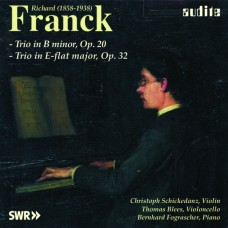您的購物車沒有添加專輯!
搜尋
法朗克:兩首鋼琴三重奏 R. Franck: Piano Trio Op. 20 & Op. 32
|
The works of Mendelssohn's friend and pupil Eduard Franck have recently become known to a broader public again, thanks in no small measure to the recent series of new recordings issued by audite. The compositions of his son, Richard, equally deserve to be rediscovered. Richard Franck studied with Mendelssohn's successor, Carl Reinecke, at the Leipzig Conservatory and played a central role in the musical life of various European cities as an interpreter, conductor and composer of numerous orchestral and chamber works. His first Piano Trio, Op. 20 appeared in 1893. The work's design, with the first movement in sonata form followed by movements marked Andante, Menuetto and Finale, corresponds to the classical pattern. However, Richard Franck develops impressive melodic variety and a very magical, romantic sound. The Trio, Op. 32, written just seven years later, presents a fascinating contrast, combining almost classical elements with bold harmonic progressions. But here, too, Richard Franck reveals thrilling melodic vitality. These intricate musical worlds are displayed by established experts in the field of chamber music rarities. Christoph Schickedanz, Bernhard Fograscher and Thomas Blees once again show us how exciting an expedition off the well-beaten path can be. |
|
The works of Mendelssohn's friend and pupil Eduard Franck have recently become known to a broader public again, thanks in no small measure to the recent series of new recordings issued by audite. The compositions of his son, Richard, equally deserve to be rediscovered. Richard Franck studied with Mendelssohn's successor, Carl Reinecke, at the Leipzig Conservatory and played a central role in the musical life of various European cities as an interpreter, conductor and composer of numerous orchestral and chamber works. His first Piano Trio, Op. 20 appeared in 1893. The work's design, with the first movement in sonata form followed by movements marked Andante, Menuetto and Finale, corresponds to the classical pattern. However, Richard Franck develops impressive melodic variety and a very magical, romantic sound. The Trio, Op. 32, written just seven years later, presents a fascinating contrast, combining almost classical elements with bold harmonic progressions. But here, too, Richard Franck reveals thrilling melodic vitality. These intricate musical worlds are displayed by established experts in the field of chamber music rarities. Christoph Schickedanz, Bernhard Fograscher and Thomas Blees once again show us how exciting an expedition off the well-beaten path can be. |
編號 |
曲目 |
長度 |
作詞 |
作曲 |
演奏 |
樂團 |
演唱 |
指揮 |
試聽 |
|---|


